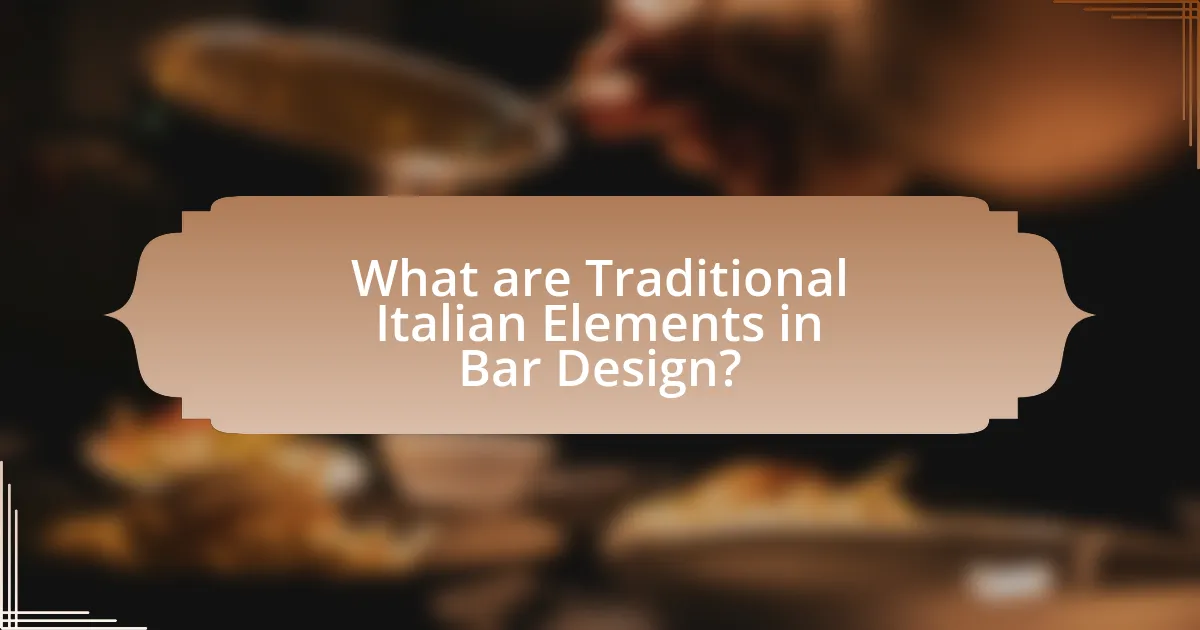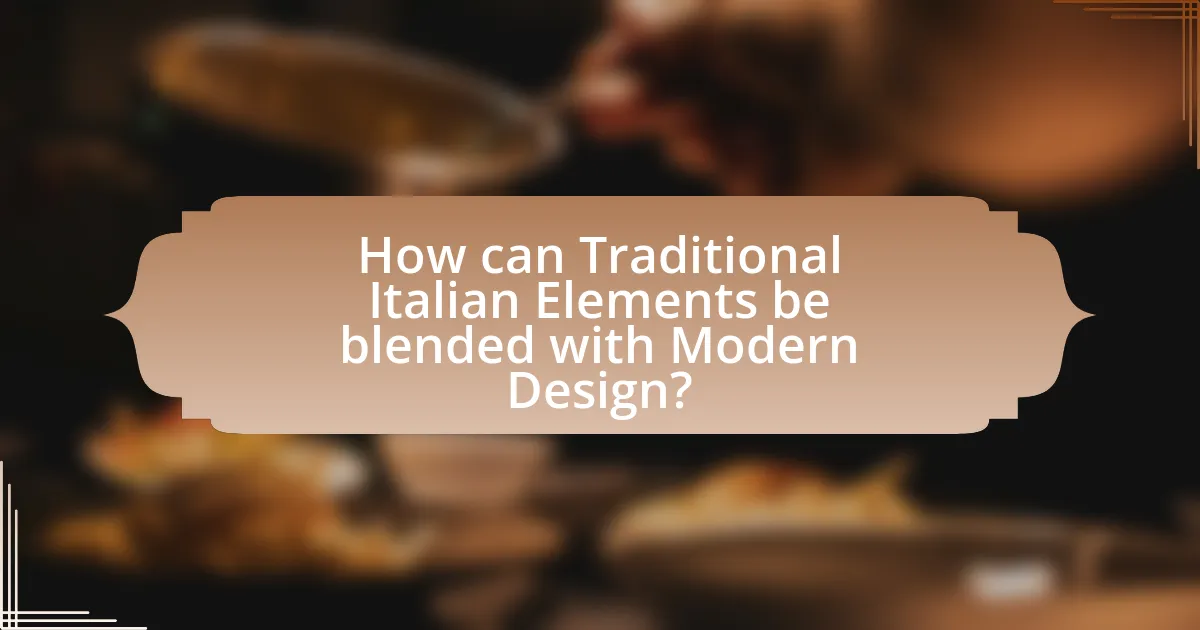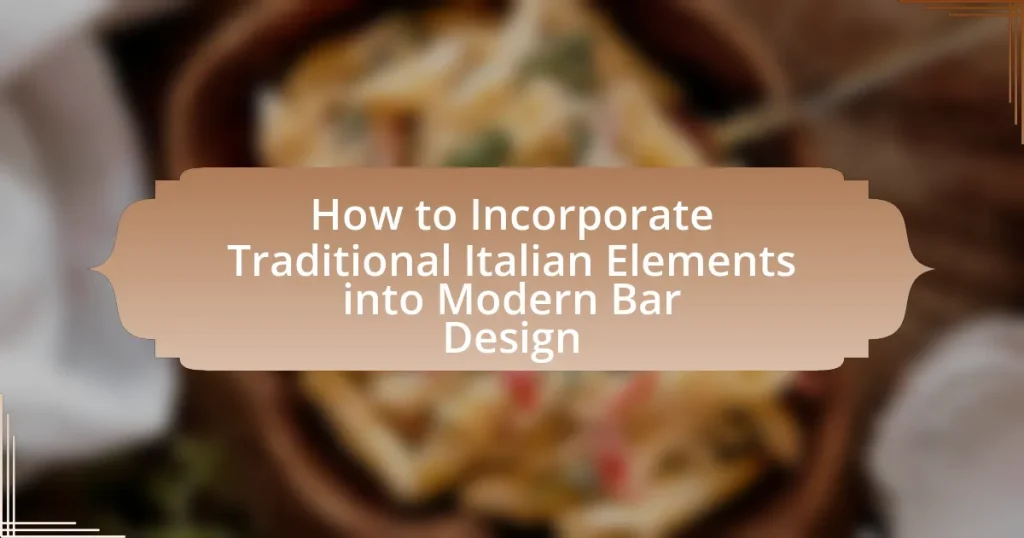The article focuses on how to incorporate traditional Italian elements into modern bar design, highlighting key aspects such as the use of warm colors, natural materials, and classic furnishings that reflect Italy’s cultural heritage. It discusses the influence of traditional design on modern aesthetics, emphasizing craftsmanship and harmonious color palettes. Specific materials like marble, wood, and wrought iron are identified as essential for creating an authentic atmosphere, while color schemes evoke the Italian landscape. The article also addresses the importance of these elements in enhancing customer experience and offers practical tips for sourcing materials and optimizing layout to achieve a cohesive design.

What are Traditional Italian Elements in Bar Design?
Traditional Italian elements in bar design include the use of warm colors, natural materials, and classic furnishings. These design choices reflect Italy’s rich cultural heritage and emphasize a welcoming atmosphere. For instance, terracotta tiles and wooden beams are commonly used to create an authentic rustic feel, while marble countertops add elegance and sophistication. Additionally, traditional Italian bars often feature vintage decor, such as antique mirrors and ornate lighting fixtures, which enhance the overall aesthetic and create a sense of history. These elements not only contribute to the visual appeal but also foster a social environment that encourages interaction, mirroring the communal spirit found in Italian culture.
How do Traditional Italian Elements influence modern aesthetics?
Traditional Italian elements significantly influence modern aesthetics by emphasizing craftsmanship, rich textures, and harmonious color palettes. These elements are evident in contemporary design through the use of artisanal materials such as marble, wood, and wrought iron, which reflect Italy’s historical emphasis on quality and detail. For instance, the resurgence of terrazzo flooring in modern spaces draws directly from traditional Italian flooring techniques, showcasing intricate patterns and durability. Additionally, the warm color schemes inspired by Italian landscapes, such as terracotta and olive green, create inviting atmospheres in modern interiors. This blend of historical significance and contemporary application illustrates how traditional Italian design principles continue to shape and enhance modern aesthetics.
What specific materials are commonly used in Traditional Italian bar design?
Traditional Italian bar design commonly utilizes materials such as marble, wood, and wrought iron. Marble is often used for countertops and flooring due to its elegance and durability, reflecting the classic Italian aesthetic. Wood, particularly dark or richly stained varieties, is frequently employed for cabinetry and furniture, providing warmth and a rustic charm. Wrought iron is typically used for decorative elements, such as railings and light fixtures, adding an artisanal touch that is characteristic of traditional Italian craftsmanship. These materials collectively create an inviting and authentic atmosphere that is central to the design of traditional Italian bars.
How do color schemes reflect Italian culture in bar design?
Color schemes in bar design reflect Italian culture through the use of warm, earthy tones and vibrant colors that evoke the Italian landscape and heritage. For instance, terracotta, olive green, and deep reds are commonly used to represent the rustic charm of Italian countryside and traditional architecture. These colors not only create an inviting atmosphere but also resonate with the Italian emphasis on family and community, as seen in the design of local trattorias and cafes. Historical context supports this, as the Italian Renaissance celebrated rich color palettes that symbolized wealth and artistry, influencing modern bar aesthetics.
Why is it important to incorporate these elements into modern bar design?
Incorporating traditional Italian elements into modern bar design is important because it enhances the cultural authenticity and aesthetic appeal of the space. These elements, such as classic materials, colors, and architectural features, create a unique atmosphere that attracts customers seeking an immersive experience. Research indicates that establishments with a strong thematic design can increase customer retention and satisfaction, as evidenced by a study published in the Journal of Hospitality and Tourism Research, which found that ambiance significantly influences consumer behavior in dining environments. Therefore, integrating these traditional aspects not only honors Italian heritage but also contributes to the overall success of the bar.
What cultural significance do Traditional Italian elements bring to a bar?
Traditional Italian elements bring a rich cultural significance to a bar by embodying the values of community, craftsmanship, and culinary heritage. These elements, such as classic decor, authentic Italian beverages, and traditional food offerings, create an inviting atmosphere that encourages social interaction and connection among patrons. The use of materials like marble and wood in bar design reflects Italy’s artisanal craftsmanship, which has historical roots in regions known for their skilled artisans. Additionally, incorporating traditional Italian drinks, such as espresso and aperitivo, highlights Italy’s deep-rooted coffee culture and dining customs, fostering a sense of authenticity and cultural appreciation. This blend of aesthetics and culinary tradition not only enhances the bar’s ambiance but also educates patrons about Italian culture, making the experience more enriching and memorable.
How can these elements enhance the customer experience?
Incorporating traditional Italian elements into modern bar design can significantly enhance the customer experience by creating an inviting and culturally rich atmosphere. These elements, such as rustic wooden furniture, vintage Italian decor, and authentic Italian cuisine, evoke a sense of warmth and nostalgia, making customers feel more connected to the space. Research indicates that environments reflecting cultural authenticity can increase customer satisfaction and loyalty, as they provide a unique and memorable experience. For instance, a study published in the Journal of Hospitality and Tourism Research found that themed environments positively influence customer emotions and perceptions, leading to longer visits and increased spending.

How can Traditional Italian Elements be blended with Modern Design?
Traditional Italian elements can be blended with modern design by integrating classic materials, colors, and motifs into contemporary aesthetics. For instance, using terracotta tiles or marble countertops, which are staples in Italian architecture, can create a tactile contrast with sleek, minimalist furniture. Additionally, incorporating traditional Italian color palettes, such as warm earth tones or vibrant reds and greens, can enhance the modern space while paying homage to Italian heritage.
The use of artisanal craftsmanship, such as hand-painted ceramics or wrought iron fixtures, can also bridge the gap between the old and the new, adding character and authenticity to modern designs. This approach not only preserves the cultural significance of traditional Italian elements but also creates a unique and inviting atmosphere in modern bar settings.
What are effective strategies for merging traditional and modern styles?
Effective strategies for merging traditional and modern styles include using a balanced color palette, integrating classic materials with contemporary finishes, and incorporating traditional motifs into modern designs. For instance, a bar design can feature rich wood paneling alongside sleek metal fixtures, creating a visual dialogue between the two styles. Additionally, employing traditional Italian elements, such as ornate tile work or vintage lighting, can enhance the modern aesthetic while maintaining cultural authenticity. This approach not only respects historical craftsmanship but also appeals to contemporary sensibilities, resulting in a cohesive and inviting space.
How can furniture choices reflect both Traditional Italian and modern design?
Furniture choices can reflect both Traditional Italian and modern design by combining classic materials and craftsmanship with contemporary forms and functionality. Traditional Italian design often emphasizes rich woods, intricate carvings, and ornate details, while modern design favors minimalism, clean lines, and innovative materials. For example, a bar stool that features a sleek, modern silhouette made from metal or molded plastic can incorporate traditional Italian elements through upholstery in luxurious fabrics like velvet or leather, showcasing craftsmanship through hand-stitched details. This blend allows for a harmonious aesthetic that respects historical influences while embracing modern sensibilities, creating a space that is both timeless and current.
What role does lighting play in this design fusion?
Lighting plays a crucial role in the design fusion of traditional Italian elements and modern bar aesthetics by enhancing ambiance and highlighting architectural features. Effective lighting can evoke the warmth and intimacy characteristic of traditional Italian spaces while simultaneously providing a contemporary edge through modern fixtures. For instance, the use of soft, warm-toned lighting can create a welcoming atmosphere reminiscent of Italian trattorias, while sleek, minimalist light designs can introduce a modern flair. This duality not only respects the heritage of Italian design but also appeals to contemporary sensibilities, making the space inviting and visually appealing.
What challenges might arise when incorporating these elements?
Incorporating traditional Italian elements into modern bar design may present challenges such as balancing authenticity with contemporary aesthetics. Designers must ensure that the traditional elements, like rustic materials or classic color palettes, do not clash with modern design principles, which often favor minimalism and sleek lines. Additionally, sourcing authentic materials can be difficult and costly, as they may not be readily available or may require specialized craftsmanship. Furthermore, there is a risk of alienating a modern clientele if the design leans too heavily on traditional motifs, potentially leading to a space that feels outdated rather than innovative.
How can one overcome design conflicts between traditional and modern aesthetics?
To overcome design conflicts between traditional and modern aesthetics, one can create a cohesive design narrative that blends elements from both styles. This can be achieved by selecting a color palette that harmonizes traditional hues with modern tones, ensuring that materials like wood and metal are used in a complementary manner. For instance, incorporating traditional Italian materials such as terracotta or marble alongside sleek, contemporary finishes can bridge the gap between the two aesthetics. Historical context supports this approach, as many successful designs in hospitality spaces have utilized a mix of styles to create unique atmospheres that appeal to diverse clientele.
What are common pitfalls to avoid in this design process?
Common pitfalls to avoid in the design process of incorporating traditional Italian elements into modern bar design include neglecting cultural authenticity, overlooking functional requirements, and failing to balance aesthetics with practicality. Neglecting cultural authenticity can lead to a design that feels inauthentic or superficial, which diminishes the overall experience; for instance, using generic decor instead of genuine Italian materials can misrepresent the culture. Overlooking functional requirements, such as adequate space for movement and service, can result in a layout that hinders operations, as evidenced by studies showing that poorly designed spaces can reduce efficiency by up to 30%. Lastly, failing to balance aesthetics with practicality can lead to visually appealing designs that are not user-friendly, which can negatively impact customer satisfaction and operational flow.

What are Practical Tips for Implementing Traditional Italian Elements in Modern Bars?
To implement traditional Italian elements in modern bars, focus on incorporating authentic materials, classic Italian beverages, and traditional design aesthetics. Using materials like terracotta tiles, marble countertops, and wooden furniture can evoke the rustic charm of Italy. Offering classic Italian drinks such as Negronis, Spritzes, and espresso not only enhances the menu but also aligns with Italian culture, which emphasizes quality ingredients and craftsmanship. Additionally, integrating design features like vintage Italian posters, warm lighting, and communal seating arrangements can create an inviting atmosphere reminiscent of traditional Italian bars. These elements collectively enhance the bar’s authenticity and appeal, drawing inspiration from Italy’s rich culinary and social traditions.
How can bar owners effectively source traditional materials?
Bar owners can effectively source traditional materials by establishing relationships with local artisans and suppliers who specialize in authentic Italian craftsmanship. Engaging with regional markets and trade shows can provide direct access to unique materials such as handcrafted tiles, vintage furniture, and artisanal glassware, which are essential for creating an authentic atmosphere. Additionally, utilizing online platforms that focus on sustainable and traditional materials can broaden sourcing options. For instance, the Italian Trade Agency offers resources and connections to suppliers of traditional materials, ensuring quality and authenticity in the sourcing process.
What are the best places to find authentic Italian design elements?
The best places to find authentic Italian design elements include Italy’s renowned design districts, such as Milan’s Brera and Tortona, which host numerous showrooms and galleries showcasing classic and contemporary Italian design. Additionally, visiting local artisan workshops in regions like Tuscany and Veneto provides access to handcrafted furniture and decor that embody traditional Italian craftsmanship. Major design fairs, such as Salone del Mobile in Milan, also feature a wide array of authentic Italian design elements from various manufacturers and designers, ensuring a comprehensive selection of styles and influences.
How can one ensure quality when sourcing these materials?
To ensure quality when sourcing materials for incorporating traditional Italian elements into modern bar design, one should prioritize selecting reputable suppliers known for their craftsmanship and authenticity. Researching suppliers’ backgrounds, reading reviews, and requesting samples can help verify the quality of materials such as wood, stone, and textiles. Additionally, sourcing materials that are certified or have a history of traditional use in Italian design, such as Carrara marble or specific types of Italian leather, can further guarantee quality. Engaging with local artisans who specialize in traditional Italian techniques can also enhance the authenticity and quality of the materials used.
What design features should be prioritized for maximum impact?
To achieve maximum impact in incorporating traditional Italian elements into modern bar design, prioritize features such as authentic materials, color palettes, and spatial layouts. Authentic materials like terracotta tiles and reclaimed wood evoke the rustic charm of Italy, while a color palette inspired by the Italian landscape—rich earth tones and vibrant hues—creates an inviting atmosphere. Spatial layouts should emphasize communal seating arrangements, reflecting the Italian culture of socializing over food and drink. These design features not only enhance aesthetic appeal but also foster a sense of community, which is central to the Italian dining experience.
How can layout and flow be optimized to highlight traditional elements?
To optimize layout and flow for highlighting traditional elements in modern bar design, designers should prioritize spatial arrangement and visual hierarchy. By strategically placing traditional elements, such as vintage furnishings or classic Italian decor, in focal points of the layout, they draw attention and create a narrative that resonates with the bar’s theme. For instance, using a central bar counter made of reclaimed wood can serve as a visual anchor, while surrounding it with traditional Italian artwork enhances the cultural ambiance. Research indicates that spatial organization significantly influences customer experience, as evidenced by studies showing that well-structured environments lead to increased patron satisfaction and longer dwell times. Therefore, a thoughtful layout that emphasizes traditional elements not only enhances aesthetic appeal but also improves overall customer engagement.
What finishing touches can enhance the overall design theme?
Incorporating traditional Italian elements into modern bar design can be enhanced by adding authentic materials, such as terracotta tiles and reclaimed wood, which evoke a rustic charm. These materials not only reflect Italian craftsmanship but also create a warm and inviting atmosphere, essential for a bar setting. For instance, terracotta tiles have been used in Italian architecture for centuries, providing durability and aesthetic appeal. Additionally, incorporating vintage Italian glassware and ceramics as decorative accents can further reinforce the theme, as these items often feature intricate designs that celebrate Italian artistry. Using soft, ambient lighting can also enhance the overall design theme by creating a cozy environment reminiscent of traditional Italian taverns.










